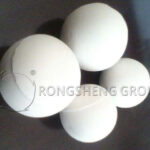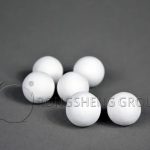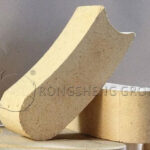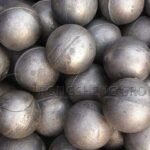Precision ceramic balls, as indispensable key components in modern industry, have demonstrated superior performance compared to traditional metal balls (such as bearing steel balls and stainless steel balls) in multiple fields due to their unique material properties. They are not only lighter and harder, but also possess multiple advantages such as wear resistance, non-magnetism, rust prevention, corrosion resistance, and non-conductivity. This greatly expands their application range and improves equipment operating efficiency and lifespan. This article mainly discusses the characteristics of four mainstream precision ceramic balls—silicon nitride, silicon carbide, zirconium oxide, and alumina—and their differences, aiming to provide users with a clear and comprehensive understanding.

Silicon nitride (Si3N4) Ceramic Balls
Silicon nitride ceramic balls are renowned for their extremely high hardness and excellent wear resistance. Their hardness is second only to diamond and cubic boron nitride, far exceeding that of traditional bearing materials. This characteristic allows silicon nitride ceramic balls to perform exceptionally well under high loads, high speeds, and extreme temperature conditions, making them widely used in aerospace, high-speed spindles, and precision machinery. Furthermore, silicon nitride ceramic balls possess good thermal shock resistance and chemical stability, maintaining stable dimensions and shape in harsh environments and reducing performance degradation caused by thermal expansion or chemical corrosion. However, silicon nitride has drawbacks: relatively high brittleness, higher processing difficulty, and correspondingly higher cost, which limits its widespread adoption in certain low-cost applications.

Silicon carbide (SiC) ceramic balls
Silicon carbide ceramic balls are ideal for high-speed, high-temperature environments due to their extremely high hardness, excellent wear resistance, and very high thermal conductivity. Their hardness is second only to silicon nitride, but they have relatively better toughness, allowing them to withstand greater impact without easily breaking. The high-temperature resistance of silicon carbide ceramic balls is particularly outstanding, maintaining excellent performance in environments up to 1600℃. Therefore, they are widely used in oil drilling, automotive turbochargers, high-temperature furnaces, and other fields. Furthermore, the low density and good self-lubricating properties of silicon carbide also make it excellent in reducing energy consumption and improving mechanical efficiency. However, the manufacturing cost of silicon carbide is also relatively high, and the processing easily generates dust, requiring certain environmental conditions.

Zirconia (ZrO2) Ceramic Balls
Zirconium oxide ceramic balls are highly favored for their excellent fracture toughness and good overall mechanical properties. They possess high hardness and wear resistance while exhibiting good toughness, which to some extent compensates for the brittleness of silicon nitride and silicon carbide. Zirconia ceramic balls also have good biocompatibility, thus finding wide applications in medical implants, dental instruments, and other fields. Furthermore, the low thermal conductivity and good chemical stability of zirconia make it excellent for industries such as food processing and pharmaceuticals where contamination and cross-reactions must be avoided. However, the strength of zirconia decreases at high temperatures, limiting its application in extremely high-temperature environments.
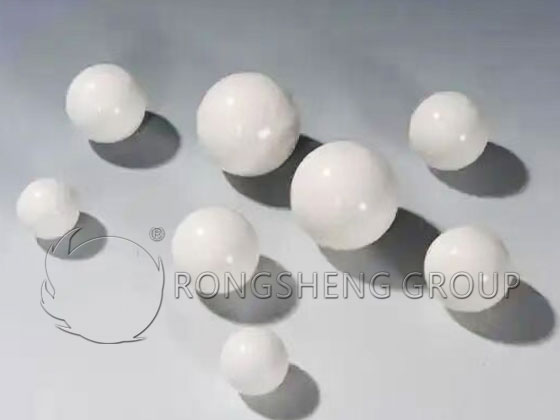
Alumina (Al2O3) Ceramic Balls
Alumina ceramic balls are among the most common and relatively inexpensive types of precision ceramic balls. They possess high hardness, good wear resistance and corrosion resistance, and excellent insulation properties, making them widely used in electronics, chemical, food processing, and many other industries. The manufacturing process for alumina ceramic balls is mature, they are easily processed into various shapes and sizes, and they are cost-effective, making them the preferred material for bearings and seals in many low-to-medium load, medium-temperature environments. Although their performance is not as outstanding as silicon nitride or silicon carbide, alumina ceramic balls are sufficient for many conventional applications and have lower maintenance costs.
Differences and Selection Criteria Among Four Types of Ceramic Ball Materials
Each of the four types of precision ceramic balls has its own advantages, and the selection should be based on a comprehensive consideration of the specific application scenario. Silicon nitride and silicon carbide, due to their extremely high hardness and wear resistance, are more suitable for extreme environments involving high speed, high temperature, and heavy loads. Zirconia, with its good toughness and biocompatibility, has unique advantages in medical and specific industrial fields. Alumina, on the other hand, is widely used in various conventional working conditions due to its economic practicality and ease of processing.
Characteristics and Differences of Four Types of Ceramic Balls
In practical applications, factors such as material cost-effectiveness, processing difficulty, and environmental adaptability must also be considered. For example, while silicon nitride and silicon carbide offer excellent performance, their high cost may deter some projects. Alumina, although having moderate performance, is inexpensive and easy to process, making it suitable for large-scale production applications. Furthermore, the surface treatment methods (such as polishing and coating) of different ceramic balls will also affect their final performance and should be customized according to specific needs.
In summary, selecting precision ceramic balls is a process that comprehensively considers material performance, cost-effectiveness, processing difficulty, and the application environment. With the advancement of technology and continuous innovation in manufacturing techniques, the types of materials and application fields of precision ceramic balls will continue to expand in the future, injecting more vitality into the development of modern industry. For engineers and designers, a thorough understanding of the characteristics and differences of various materials is key to ensuring the selection of the most suitable precision ceramic balls for their project needs.
RS Alumina Ceramic Ball Manufacturer supplies ceramic ball products of various specifications. Contact RS Factory for free samples and quotations.


